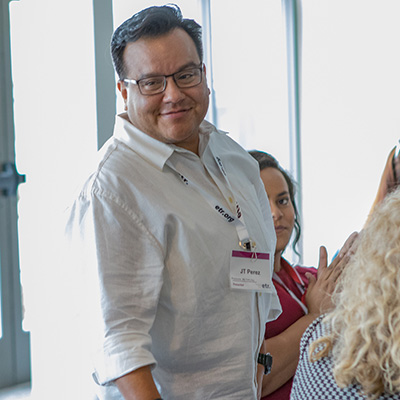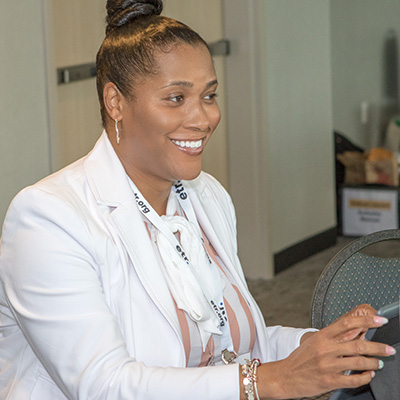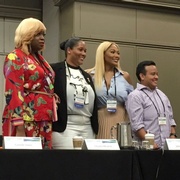We ARE the Demonstration: Professional Development by and for Transgender Communities
By JT Perez, Jahnell Butler, Tatyana Moaton & Camille Lewis | April 23, 2019
ETR Consultants; Prevention Educator, Alianza (JTP); Human Resources Manager for Howard Brown Health (TM); Translluminati Program Manager (CL)
How do we increase the effectiveness of High Impact HIV prevention? How do we reach the individuals and communities most at risk with strategies that work?
One of the most important steps we can take is to identify who those individuals and communities are, then engage their leaders to create and deliver prevention programs. Our group represents one approach to this strategy.
We are all members of transgender communities. Our communities are experiencing new HIV diagnoses at rates more than three times the national average. We are all working to promote health and HIV prevention in our communities.
We are the demonstration of high impact prevention.
Practical Solutions
Because of our own experiences, we know that this can be a challenging process. Our communities are highly varied. Our members have experienced significant inequities in education, health and opportunity. It can be difficult to find qualified leaders. It can be challenging to create trust between community members and prevention programs.
There are workable, practical solutions to these challenges. We have a number of lessons to share from our experience as members of the transgender HIV/AIDS workforce. Strategies such as these can boost the effectiveness of projects supporting transgender communities across the nation and increase the competencies of our transgender workforce.
JT Perez: Translating High Impact Prevention Theory into Practice
 The CDC’s surveillance data indicates that about 1 in 4 trans women is currently living with HIV. But this is actually very limited data that misses many trans women and does not include information on trans men, gender non-conforming people and those who are non-binary.
The CDC’s surveillance data indicates that about 1 in 4 trans women is currently living with HIV. But this is actually very limited data that misses many trans women and does not include information on trans men, gender non-conforming people and those who are non-binary.
We need to focus more attention on the range of gender experience, identities and expressions people bring to their lives. That means recognizing identities beyond cisgender, and I promise you there are more than two non-cis options.
Some federal, state and local agencies do not collect or have complete data on transgender individuals. Using the two-step data collection method of asking for sex assigned at birth and current gender identity allows individuals to accurately self-identify and increases the likelihood that people are correctly identified in surveillance programs.
An Example: Screening for Support Services
I worked with an agency that provided HIV testing, syringe exchange and other support services. We had a screening questionnaire people filled out before being tested. The form only had two transgender identities—FTM (female to male) or MTF (male to female). When I raised concerns about the limitations of the form, our program director asked me to “prove” that we had enough people who identified in other ways to justify changing the form. That created a lot of burden for a busy and understaffed program. Thankfully, a new manager came in and decided the entire form was a barrier and no longer needed.
To provide a welcoming and inclusive service environment for all, agencies should adapt their intake and assessment forms beyond binary constructs of gender. The option to mark a box labelled “other” is not inclusive. It is offensive. There are many examples and samples of ways to adapt agency forms. Here is a helpful policy brief from the National LGBT Health Education Center. To be effective in our high impact work, we must respect the fact that gender is expressed along a spectrum, just as sexuality is.
Jahnell Butler: Facilitation Skills for Dynamic Presentations to Engage the Transgender Community
 People of trans experience need HIV information and education. When our prevention groups use effective communication skills, we are much more likely to see meaningful exchanges among participants. HIV is not always a participant’s top priority, but it is a part of our community’s reality. Through honesty and trust, we can reach through resistance and make a difference.
People of trans experience need HIV information and education. When our prevention groups use effective communication skills, we are much more likely to see meaningful exchanges among participants. HIV is not always a participant’s top priority, but it is a part of our community’s reality. Through honesty and trust, we can reach through resistance and make a difference.
It is essential to use ground rules to create a safe space for these groups. It’s not easy to just jump in and start talking about all the things we need to discuss when we talk about HIV prevention. It is also important to honor the lived experience of each individual participating. I cannot make assumptions that I know everyone’s story just because I am a trans woman. Every story is different, and I need to communicate that clearly in the way I facilitate a group—through my words, actions and expressions.
Motivational Interviewing uses an approach called OARS, which stands for Open-ended questions, Affirmations, Reflections and Summary. These are effective strategies in our group process, allowing us to build trust, behave with integrity, and deepen learning and knowledge retention.
In my experience, especially in the trans groups I have facilitated, self-reflection is also essential. I allow everyone to be the expert of their own lives and their own communities. I make the effort to be aware of my own assumptions and values so these don’t interfere with what participants are saying.
Examples: OARS in Practice
Open-ended questions: A facilitator’s goal is not to provide answers. It is to facilitate a conversation in which participants are guided to give voice to their own answers. Open-ended questions encourage participants to speak broadly and share their own insights. Examples:
- “What was that like?”
- “How did it feel?”
- “Help me understand what you’re saying.”
Affirmations: Affirmations are statements of appreciation and understanding. They can be used to validate strengths, efforts and experiences. This experience of being affirmed, rather than criticized, for perspectives and experiences is quite powerful and is sometimes new for participants. Examples:
- “That is a great point.”
- “It sounds like you’ve thought deeply about this.”
Reflective listening: This shares back to the speaker the key message you are hearing. It can encourage conversation, reinforce learning and keep the focus on a topic you want to emphasize. The statements are not challenging or “combative,” but phrased in a way that invites clarification. Examples:
- Repeat back the speaker’s exact words, or a phrase from their statement.
- Paraphrase—state the message in your own words.
- Reflect—use stem sentences that communicate that you are listening, such as, “I’m hearing you say…” or “It sounds like you feel…”
Summary: Summary allows the facilitator to highlight main points and link together information and learning that has been shared by multiple participants. It can guide the group toward key take-aways. A summary is like a flashlight you shine on the conversation. Focus on what you want participants to remember.
Tatyana Moaton: Management Skills for Program Success in the Trans Community
 Unemployment and under-employment is high in the trans community. I know this from both personal experiences in the community and from nationwide data. Last year, we conducted an Organizational Assessment prior to our Trans Professional Development Institute. A clear finding from this assessment was that a factor contributing to the attrition of trans individuals was the lack of soft skills—things like being able to listen, manage your time, lead a meeting, or work well with different groups of people.
Unemployment and under-employment is high in the trans community. I know this from both personal experiences in the community and from nationwide data. Last year, we conducted an Organizational Assessment prior to our Trans Professional Development Institute. A clear finding from this assessment was that a factor contributing to the attrition of trans individuals was the lack of soft skills—things like being able to listen, manage your time, lead a meeting, or work well with different groups of people.
Project management skills can be applied to any field, and they can also help us manage our own lives more effectively. Learning the technical aspects of project management can build the skills of the transgender workforce. If you have a time-limited project and have employed members of the transgender workforce, offer opportunities for them to master these invaluable skills. They will leave your project better prepared to continue contributing to their communities and they'll have built up their own resources and successes.
Steps like this can help address some of the inequities that come from unemployment and under-employment.
Examples: 5 Steps in Project Management
Understanding project management helps members of the HIV workforce appreciate that it is important to outline their work from the start, and assess and adapt their work over time. I like training to this 5-step model.
- Initiating. Determining the nature and scope of the project. This is vital. If it is not performed well, it is unlikely the project will be successful in accomplishing its goals.
- Planning. Planning time, costs and resources adequately.
- Executing. Ensuring that deliverables are fulfilled.
- Monitoring. Tracking the work plan to identify mid-course successes and any necessary corrective actions.
- Evaluation. Assessing the success of the project.
Camille Lewis: Developing Strategic Leadership in the Trans Community
 I believe it is time to embrace leadership as a verb. Being a leader isn’t just about having a title or the power to make decisions. It’s an ever changing, ongoing action that we must work on continuously.
I believe it is time to embrace leadership as a verb. Being a leader isn’t just about having a title or the power to make decisions. It’s an ever changing, ongoing action that we must work on continuously.
In high impact prevention with transgender communities, leaders must know and understand the trans population. I can be a successful leader in my program because I work every day to learn more about our clients. I know that each person who comes into our program will continue to help me understand more.
I train to a model called situational leadership. This is based on the work of Kenneth Blanchard and Paul Hersey. In this model, leaders or managers adjust their style in an ongoing way to fit the developmental level of the staff. It’s up to the leader to discover the style that works with the staff. Staff members should not be changing to adapt to the leader’s style.
The key to understanding and harnessing the power of leadership is paying attention to the ways people respond to working and being led in groups. How much guidance and direction do staff need from you as a leader? How much social and emotional support do staff need? How do you assess a staff member’s readiness to complete a specific task or function?
Earlier in this post, Tatyana mentioned that many members of the trans community come into the HIV workforce without experience in project management. As a program leader, I have a responsibility to nurture skills and relationships of staff in ways that meet both their needs for professional development and those of our program and clients. Situational leadership is an excellent model that allows us to identify talent and build new skills in a way that honors and respects our staff’s experiences and potential.
Examples: 4 Situational Leadership Styles
As a leader, you select a style based on the needs of staff in each particular situation. These variables are fluid and interactive.
- Directing. When the staff member lacks either the skills or motivation to do the job, the leader takes a directive role. This involves telling the staff member what to do. It may involve learning more about why the person is unmotivated or unable to complete the tasks.
- Coaching. When the staff member does not have all of the skills needed, but does have motivation to complete tasks well, the leader coaches the staff member towards improvement.
- Supporting. When the staff member has the skills but lacks commitment, the leader needs to focus on motivation. The focus is on discovering what will persuade the worker to cooperate on the tasks.
- Delegating. When the staff member has both necessary skills and high motivation, the leader can basically “leave them to it,” trusting them to complete the tasks. The leader keeps a relatively distant eye on things to ensure everything is going according to plan.
Empowering Communities to Make the Difference
Today’s HIV epidemic presents some fierce challenges in transgender communities. We understand that it can be difficult to reach the individuals most at risk. We are not, however, complacent about this. We have had good success with our strategies. Our programs are making a difference.
Our goal now is for more programs to put these strategies to work, and for our nation to support the continuing development of a competent and capable transgender workforce. We hope you will join enthusiastically in this effort.
The authors of this post presented a panel sharing these ideas, along with some of their personal experiences, at the 2019 National HIV Prevention Conference. They are continuing to share these strategies through additional presentations.
JT Perez is an ETR consultant and a Prevention Educator with Alianza in Las Cruces, New Mexico. He has contributed previously to ETR’s blog. He can be reached at jtperez.pride@gmail.com.
Jahnell Butler is an ETR consultant based in Rochester, New York. She can be reached at jahnellmeezan@yahoo.com.
Tatyana Moaton is an ETR consultant and a Human Resources Manager for Howard Brown Health in Chicago, Illinois. She can be reached at tatyanam@envisionconsult.org.
Camille Lewis is an ETR consultant and Program Manager at Translluminati in Miami, Florida. She can be reached at camillestepford@gmail.com.




